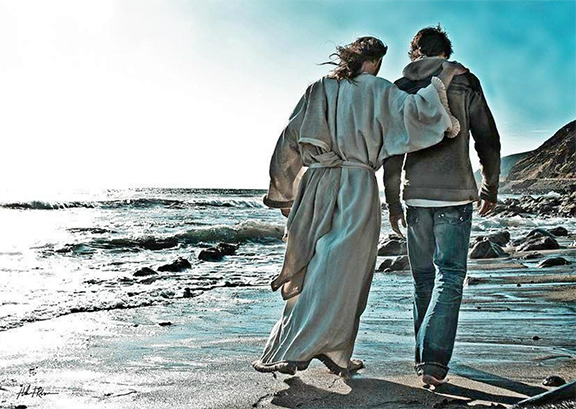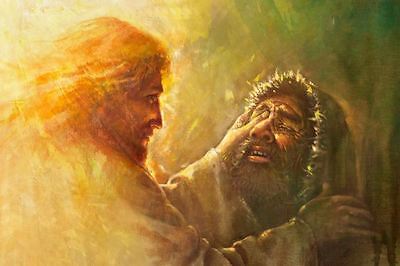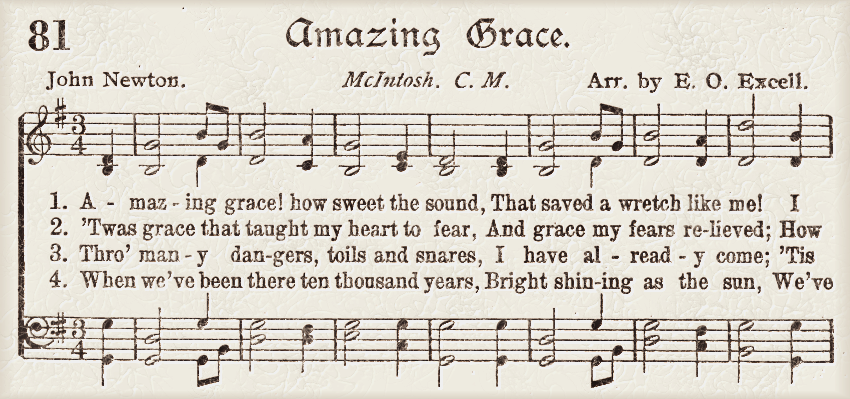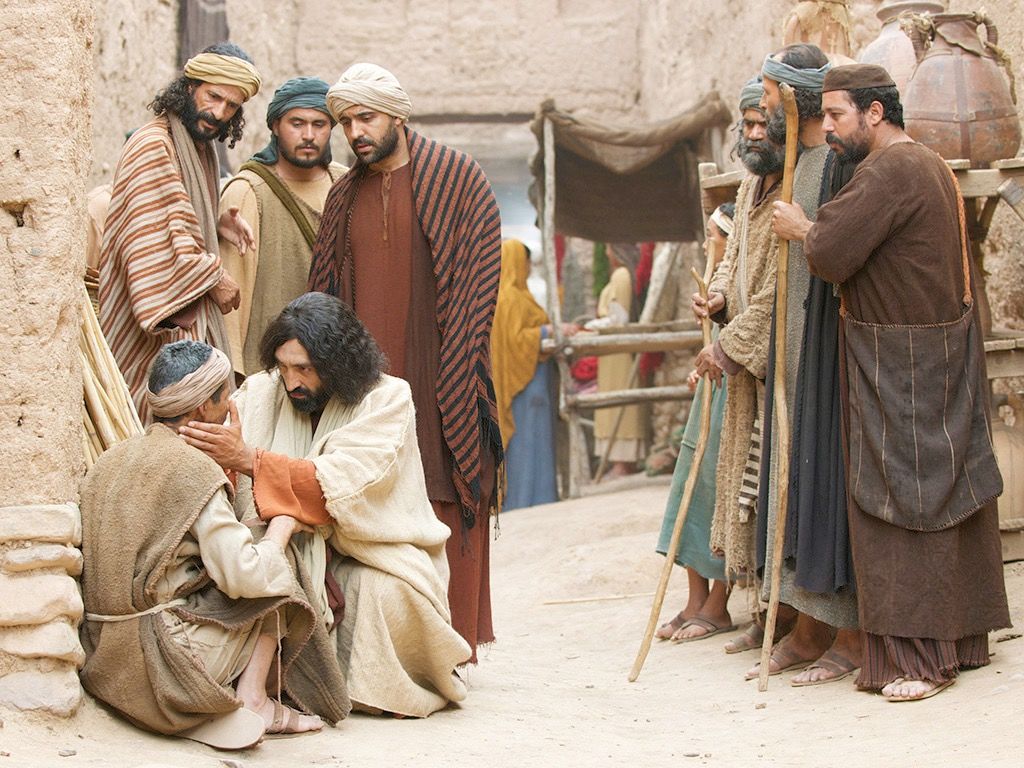
John 9 – Follow In His Steps
Jesus told us that as faithful disciples we need to follow in His footsteps. Many times while He was on earth He would say “follow Me”, when calling His disciples (Matt. 9:9; Mk. 1:17; Jn. 1:43) and when He was explaining being His disciple (Lu. 9:23; 14:27; Jn. 10:27; 12:26 ). Peter put it this way: “For you have been called for this purpose, since Christ also suffered for you, leaving you an example for you to follow in His steps” (1 Pet. 2:21). Jesus certainly gave us the perfect and complete model for godliness and  faithfulness to God’s mission. In John 9, we see Jesus and His disciples as they continue to walk together, learning and ministering. The disciples must have been learning a lot from this man Who was God in the flesh as they would journey together. John has been sharing that journey with us and in Jn. 9 he continues to give us time references that help us to see the sequence of events.
faithfulness to God’s mission. In John 9, we see Jesus and His disciples as they continue to walk together, learning and ministering. The disciples must have been learning a lot from this man Who was God in the flesh as they would journey together. John has been sharing that journey with us and in Jn. 9 he continues to give us time references that help us to see the sequence of events.
- The phrases “After these things” or “as He passed by” started with Jn. 5:1; 6:1, 22. Now this sequence continues:
- 7:1 – “After these things…” – Jesus ends up going to Jerusalem for another Feast of Tabernacles.
- 8:1 – He goes across the Kidron valley to the Mt. of Olives after the Feast and is teaching. He may have been staying there the whole week of the feast, as He had done during the last Passover six months later just before the Cross. Note that the Pharisees approach Jesus with the woman caught in questionable circumstances, perhaps with a conspiring lover.
- 9:1 – Note more sequence and progress of time here, “as Jesus passed by”. He is likely still in Jerusalem, proceeding right after the confrontation of ch. 8:12.
- John 7-10 is a story of “high intensity hatred”
- These chapters provide many details about the opposition Jesus faced while being in Jerusalem leading up to His last Feast of Tabernacles.
- In the midst of such trials, Jesus still cared for His followers:
- 7:37 – refreshment
- 8:12 – rejoicing
- 9 – rest
- 10 – Protection and Provision by the Shepherd
- This passage is ultimately culminated in Jn. 11:45-57 with the plot to kill Jesus that takes Him to the Cross
Bible Study Journal
Review! Take time now to do a read-through of John 7-11 so that you can better grasp where we are in the Life of Christ. As you do this review, make notes in your Journal of things that catch your attention, make more sense after your studies, etc.

The Blind Man Calls Their Bluff
Why did Jesus do miracles?
Jesus did miracles to meet human need, but they were also to be a “road sign” pointing observers in the right direction to discover the truth of God’s Son as t he Messiah. They were also an open opportunity for His message of spiritual truth to be heard. He also wanted to display His “credentials” as the Son of God, demonstrating that He is the promised Messiah.
he Messiah. They were also an open opportunity for His message of spiritual truth to be heard. He also wanted to display His “credentials” as the Son of God, demonstrating that He is the promised Messiah.
![]() The OT prophecies often spoke of the Messiah performing miracles. Look Up Isa. 35:5-6 – “The blind receive their sight” is a Messianic truth about the Messiah performing miracles.
The OT prophecies often spoke of the Messiah performing miracles. Look Up Isa. 35:5-6 – “The blind receive their sight” is a Messianic truth about the Messiah performing miracles.

John 9:3, the works of God are being displayed. God glorifies Himself, His purposes & glory often prevail over our will. Our “righteous” actions (amazingly) glorify Him. The blind man’s condition is an opportunity for him & for Jesus. In Jn. 9:4, “we” is referring to Jesus, His Father and the Holy Spirit. This is God’s work
John 9:5, Jesus is the Light of the World. Since He came into the world (John 1), as long as it is “daylight”, it is time for Him to be productive. The “Light of the World” is currently on earth, Christ living in those who trust Him as Savior! It is reasonable to see Jesus doing this miracle considering the context He provided by John 8:12. Jesus wants us to live this life of light, as He says Jn. 12:35, “Walk while you have the Light.” Light is very special to God, an essential part of His character, God, the most essential context: “let there be light”, Gen. 1:3.
9:1-13, Sorting Out the Drama
Outline the Passage
- v.1. What brought about the healing? The blind man had a problem, but so did the Pharisees. But most important, Jesus had a Mission.
- vv. 2-5, What was the purpose for the man’s blindness? Jesus points out God’s higher purpose for the man’s helpless condition. His sin will result in death, like all of us – but his sin didn’t cause the blindness.
- vv. 6-7, Jesus brings the power that can heal in His own way and time.
- vv. 8-13, Jesus compassion and healing power causes the perplexity of the people who witnessed the healing.
Why, why, why…
- Popular opinion of that day would place blame for physical defects/illness on the person’s sin – The disciples’ naturally thought there was a theological problem drawn into the Pharisees’ logic.
- The Truth is that ever since the Fall, God has sought to regain His fellowship with mankind, the crowning accomplishment of His precious creation- Gen. 3:16.
- Our frailty turns us back to the Creator – “that the works of God…” As difficulties bring us back to Him, we then seek to serve Him
- Sin does cause suffering – Jn 5:14; Num. 12; 1 Cor. 11:30; Jas. 5:15, but not always – Consider Job; also see 2 Cor. 12:7; Gal 4:13.
- Jesus refuted the idea that personal sin causes suffering – Iniquity may sometimes cause suffering, but our sin ultimately brings about death for all of us.
- More questions and answers…
- What’s important is Who, not What.
- Why spit & mud? There was no magical power in those. Jesus often used some type of object in His teaching – for example, when He said “I am the Great Shepherd”, He was probably surrounded by people who owned sheep.
- Background: The pool of Siloam has a special relationship to the Feast of Tabernacles. It is a fairly large pool located outside the SE corner of Jerusalem in the City of David (Bethlehem). It provided all of the fresh water inside Jerusalem. It gets its water from the Gihon spring in the Kidron valley through the amazing Hezekiah Tunnel cut through several hundred feet of solid rock
- Note that Jesus healed the blind on other occasions – Matt. 9:27-31; Mk. 8:22-26.
Jn.9:14-34, Interrogation
The Jewish Leaders wanted to be “in the news” and demonstrate that they were “in charge”. They didn’t have a desire for truth, they sought only pretense & self-preservation.
- vv. 8-12, The neighbors & observers were a little more objective and raised questions – “Is this really the one who was blind?”
- vv. 15-17, Denying God’s presence and power doesn’t change reality. Ignoring the fact of the miracle, the Pharisees question the man.
- vv. 18-23, When they question the man’s parents, their lack regard for truth is on display. The parents give the wiser response: “Go ask Jesus!”
- vv. 24-34, and then the Pharisees question the man a second time! Their selfish disregard for the man’s value. In their proud and misguided determination they say “Honor God, tell the truth!”
- Their predisposed opinion assumed Jesus was a sinner.
- The man says he has no opinion, but just one fact for sure: “I was blind, now I see!”
- Recall that John Newton wrote Amazing Grace centered on this great truth.
- v.26, What did Jesus do to accomplish this miracle? The Jews are only looking for a physical explanation. Their cold hearts could not grasp faith.
- v. 28, the Jews try to gain the high ground by saying they follow Moses, and then accuse the healed man saying maybe he’s a mistaken disciple of Jesus.
- v. 30, “here is the amazing thing…” – the blind man stands his ground.
- 34, They “put him out”, inferring they threw him out of the Temple permanently, he could no longer worship with his fellow Jews. They wanted to stir up the fear of the people – Jn 7:13; 12:42. Their scorn was their last resort when they couldn’t win the argument any other way.

Amazing grace, how sweet the sound, that saved a wretch like me.
I once was lost, but now I’m found, wWas blind, but now I see!
Undeniable Facts
- Truth & Belief
- No, really… I’m the guy! In 9:25, 30 – this man speaks up for what Jesus did for him, there is no doubt that He trusts the Savior
- Willful unbelief, v41 – Jesus condemns the Jews self-centered piety and rejection of God’s Truth – they were blind
- Skeptics today use the same “avoid and distract” tricks –
- They set false standards
- They kept claiming to need more evidence
- Their research was subjective and biased
- They rejected facts
- They protected selfish interests at all cost
- 9:36, the healed man’s belief is followed by worship and public confession, v38

- Jesus sought the man out to confirm his faith, v35 – he hadn’t known Who Jesus was, but now he “knows” Jesus in real, undeniable experience – Jesus is the Messiah!
- v. 32, 36, real freedom, “…you will know the truth, and the truth will make you free…. So if the Son makes you free, you will be free indeed.”
- 9:40-41, the Jews – “are we blind too??”
- Well, hmmm… yes!
- If they understood being lost, being “cast out into outer darkness” (Jn. 8:12), if they cried out for God’s light, then they wouldn’t be so surprised
- They thought their “dark” view of the world was enlightened, but their view rejected the Light.
 For Further Study…
For Further Study…
- What are some frequently debated topics in Christian circles?
- The disciples asked a theological question about the man born blind. How would you explain Jesus’ reply in your own words?
- What was Jesus’ main concern when He saw the blind man? What does this tell you about His priorities?
- Which are you more life – the disciples who wanted to debate the cause of the man’s blindness – or Jesus Who wanted to take care of the man’s problem? Why?
- Like the woman at the well, the blind man went through several stages of understanding Who Jesus was. Identify:
- How was it possible that the religiously trained leaders were so blind to Who Jesus was?
- Restate in your own words Jesus’ description of His mission in 9:39. What did He mean?
- What might be one of your spiritual blind spots? How can you be receptive to Jesus’ illumination in this area?
- How can you act more life Jesus this week in concern for those who are spiritually blind?



